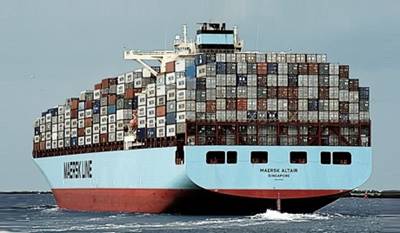
Date: 2025-10-24 Page is: DBtxt003.php txt00012099
International Trade
Shipping
Expanding Alliances to Bring More Big Ships to US Ports
Burgess COMMENTARY
Peter Burgess
Expanding Alliances to Bring More Big Ships to US Ports

Maersk Altair. Photo courtesy Maersk Line.The biggest container ship to call the Port of Charleston was the 9,640-TEU Maersk Altair. Maersk Line photo.
The advent of the P3 Network and the likely expansion of other mega-alliances among the top 20 container lines mean that vessels with capacities of 8,000 to 10,000 20-foot-equivalent units will become the workhorses of the U.S. container trades, according to Jim Newsome, president and CEO of the South Carolina Ports Authority.
When the P3 alliance among Maersk Line, Mediterranean Shipping Line, and CMA CGM launches joint east-west services sometime next spring, the other two existing alliances are likely to expand with the addition of new members. “There could be a CKYH-E alliance if Evergreen joins in with the CKYH alliance,” Newsome said, referring to the vessel-sharing alliance among Cosco, “K” Line, Yang Ming and Hanjin Shipping.
“And China Shipping and United Arab Shipping might join in also,” he said. “You could have up to seven carriers in an alliance.”
What is fueling the growth of mega-alliances is the carriers’ need to deploy large post-Panamax vessels in services that will lower their slot costs. “I told the Federal Maritime Commission that operational alliances are necessary to deploy sufficiently large container ships,” he said.
Drewry’s prediction that there will be a surplus of vessels in the 8,000 to 10,000-TEU range in coming years as more larger ships are delivered means that vessels in this range are likely to be deployed onto the U.S. trades, Newsome said.
“The expansion of alliances will mean more volatility in the container trades. The alliances will not bring pricing stability,” Newsome said in an interview with the JOC. He said the expansion of the G6 Alliance among APL, Hapag-Lloyd, Hyundai Merchant Marine, MOL, NYK Line and OOCL into the trans-Atlantic and the Asia-to-U.S. West Coast trades means it will be as big in the U.S. trades as the P3 Alliance.
The biggest container ship to call the Port of Charleston was the 9,640-TEU Maersk Altair, which was loaded with 4,800 containers at the time. It called at Charleston half empty so it could load containers for export.
Newsome said the future of all ports in the Southeast lies in the export trade as the region undergoes a manufacturing renaissance and the transloading of grain exports shipped by rail from the Middle West grows ever bigger. “We transload between 300 and 400 boxes of grain per week,” Neewsome said. Charleston already has three transload facilities around the port, and two more are expected to be built.
One of the three existing transload facilities is for plastic rather than grain. Because Gulf ports don’t have the depth or the capacity to load big ships for exports, petrochemical plants around Houston are shipping resin by rail to Charleston for transloading into containers. “We are getting 50 boxes per week, and this will increase by 2015-2016 when all the new projects around Houston come on line,” Newsome said.
Charleston, which can handle ships with up to 48 feet of draft at high tide, is in the middle of a feasibility study by the U.S. Army Corps of Engineers to deepen its harbor to up to 52 feet. “We are building a port for the next 50 years,” Newsome said, explaining why the SCPA is pushing for a 52-foot depth. “We said that East Coast ports will be getting calls by 13,000-TEU ships when the Bayonne Bridge is raised, allowing ships of that size to call the Port of New York in 2018,” he said.
Newsome said he expects the port to completed is deepening project by 2018, at the same time as it completes the new container terminal at the North Charleston Navy Base. The port will get its first ondock rail facility at the new terminal when the South Carolina Public Railways completes a $130 million intermodal container transfer facility at the former Navy Base, which will be accessible by Norfolk Southern and CSX trains. The new rail ramp will be completed by 2018.
The state of South Carolina has already set aside $120 million to fund the local share of Charleston’s $300 million harbor-deepening project. “The state put that money in the bank,” Newsome said.
Contact Peter Leach at pleach@joc.com and follow him at twitter.com/petertleach.
Port News›US Ports›Port of Charleston
Read more about mega-ships